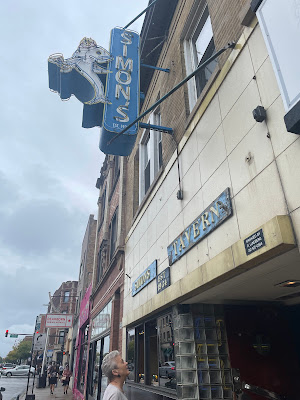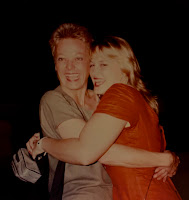Let me tell you a story. It’s about a mother and daughter who both love reading and traveling.
 |
| My mom and her friend at the Milwaukee airport, ready to board TWA to New York City, their first flight ever |
She planned two epic trips for family (twenty-four people!) to South America and Africa. Each family got a packet with itineraries, background, photos, floor plans of boats and hotels, maps, packing lists, flight info, room assignments, menus, excursion schedules, luggage weight limits, and articles about plants, animals, history, and culture. Both trips must have been at least a total of forty jets, boats, buses, Jeeps, and planes.
She planned all the trips in between--road trips, ski trips, a 3-day biking trip, a Route 66 trip, trips with her sister to India, Easter Island, Austria, a trip to meet her daughter--yes, me--in Cameroon.
So it’s no surprise that the mother’s favorite thing
about the literary trip she got for her 80th birthday
was that it was all planned for her. For once, she did
no planning at all.
In the months that the daughter planned this literary trip, she said under her breath, at least 19 times, How does mom do it?? This literary trip was only one night, two days, two people, and a 30-minute drive. And the daughter had this guide to pilfer from—which is on the Internet!, not in a printed $5-a-day guidebook or a fold-out map. And the daughter had lived and worked in Chicago for decades.
But there was the timing, the restaurant reservations, the play tickets, the bookstore and museum hours, the hotel, the parking, the logistics of getting from place to place. So it was understandable that her mother appreciated the planning as the best part of the trip gift.
And the daughter gained a fresh appreciation of the planning her mother did for the family trips. The hours and hours, days and days in the rabbit hole, crafting each twist and turn of the trip, hoping to lay the groundwork for moments of discovery and intrigue that give perspective and shape and enrich the traveler’s life.
Here is the itinerary I sent to my mom:
Did all go as planned? Of course not.
Finding our pre-paid parking for City Lit Theater was confusing. We had to wear masks in the tiny, hot, low-ceilinged theater, which made us both a little anxious.
 |
| We saw The House of Ideas about Stan Lee and Jack Kirby, the creators of the Marvel Comics world who battled each over who should get credit. |
Finding our pre-paid parking for the Publishing House was confusing. I could only get a room with one bed, which was OK, but I also forgot my pajamas. Finding our pre-paid parking for the Writers Museum was confusing. And it was infuriating to see the table of banned books at the After-Words bookstore. I bought my favorite book as a kid off that table—Blubber by Judy Blume.
Did things turn out better than planned? Yes.
We made some unexpected discoveries—
 |
| Unchartered Books’ gorgeous wallpaper and compelling objects tucked between book stacks  and a secret reading room behind a Murphy door bookshelf |
 |
| a peek at Simon’s, a bar where my best friend and I hung out in the 80s; nothing has changed since |
 |
| bought these earrings with a secret message at Milk (the secret word is upside down) |
The Tribune Tower has pieces from structures like Notre Dame, Abraham Lincoln’s tomb, The Alamo, an ancient temple in China, a post office in Dublin, the Colosseum in Rome, and a mosque in Turkey. They were collected by Chicago Tribune correspondents from the late 1800s to the 1920s and then incorporated into the building’s facade.
The Writers Museum surprised me. From what I saw online, it looked like our visit would be a slow shuffle in front of a wall as we read placards—summaries or excerpts of literary works. I imagined it would be like the Art Institute (just down the street) minus the art—just the artwork labels. I worried it would be boring.
But quite the contrary—especially the writing side. The Writers Museum is divided into two sections—reading and writing. Reading comes first and does involve a lot of reading stuff on walls. There’s even one corner that has text projected over the three walls from floor to ceiling—you can sit on round chairs and feel like you are in a book. We spent a lot of time in the reading part, trying to read as much as we could.
Next came the writing section which I wish we had saved more time for. It was fun and interactive. We typed on typewriters from early 1900s to 1980s when they began to fizzle out. Then we clipped our typed papers on a wall and read others’ writing. We pushed buttons on glass tube ticker tape-looking machines to get rolls of paper printed with stories that were 1-minute, 2-minute, or 5-minute reads.
We sat at a huge table with a screen surface. We read and touched the screen to hear readings and more information. There was a station where you could write your migration story on a luggage tag. There was a wall with excerpts of writing with some words redacted; you could guess the words using the context and style of the writing and then lift little panels to see how close you got. You could listen to interviews with and readings by authors. You could choose bookmarks with your favorite authors. It made me want to go home and write.
The center piece of our literary trip was staying The Publishing House.
In the early 1900s, Upton Sinclair sought to expose wage slavery and the inhumane conditions of the meatpacking industry in Chicago’s Packingtown (or Back of the Yards) neighborhood in his 1906 book The Jungle.
In 1909, not far from Packingtown, free methodists opened a publishing house. They printed materials with their religious beliefs that centered the well-being of all people. They advocated for women’s rights and the abolition of slavery, as well putting a stop to the exclusionary practice of renting and selling church pews.
From the early 1900s to the 1960s, the West Loop was an industrial district with warehouses, factories, and wholesale markets. After the Free Methodist Publishing House closed in 1935, the Walter Rudolph Casket Factory moved into the building. In fact, there were several casket shops in the neighborhood.
As a result of the Great Depression, the area became Skid Row into the 1970s. In 1975, Robert and Loren Billings bought the building, which then shared the area with abandoned warehouses and homeless shelters. Robert was a newspaper man. Loren learned to make holograms at the Art Institute. They opened a gallery in the building, and it eventually became the Museum of Holography—the only one in the country exclusively dedicated to holograms. The Billings have a fascinating story, which is well told in this article in the Chicago Reader.
In the late 1980s Oprah helped revitalize the neighborhood when she bought a cold storage warehouse and built Harpo Studios where her show was filmed. Thousands of visitors came to sit in the audience of one of the the most popular shows on TV at the time. Luxury stores, fine dining, and other corporations soon moved in.
Finally in 2016, a design team reimagined the building into the Bed & Breakfast it is today.
If I were to create a Bed & Breakfast, it would be just like this, with little objets d’art tucked in every corner, unique artwork, vintage furniture, upcycled this and that, …though I think mine would be more steam punk with bird cages full of plants, an old gum ball machine full of beach glass and stones, books on pipe shelves, pipe door handles, egg shells, … ok actually I am describing my studio now. But I love a place that evokes and inspires collection. I love to see how an artist puts together pieces of this and that to create a mood, an atmosphere, a vibe.
There are 11 rooms named for Chicago authors, characters, or in the case of The Second City Room, a comedy shop? Or a city nickname? I can’t find anything published that explains the rooms’ names. Maybe that’s purposeful so visitors can discover it on their own. But here’s my best guess on the names:
- A few need no explanation—The Cisneros Room, Bellow Room, and Sinclair Room.
- The Audrey Room for Audrey Niffenegger who wrote The Time Traveler’s Wife
- The Meno Room for Joe Meno who worked as an art therapy teacher in a juvenile detention center before publishing his first book at age 24

- The Harvey Room for Michael Harvey who writes crime novels I think
- The Dybek Room for Stuart Dybek, a master of flash fiction and Chicago icon
- The Rooney Room for Kathleen Rooney I assume. She is the founding editor of Rose Metal Press and wrote Lillian Boxfish Takes a Walk.
- The Everleigh Room for the sisters who had the Everleigh Club brothel in the late 1800s?
- The Carmen Room for the flamenco-dancer-despite-childhood-polio main character named Carmen in Ana Castillo’s book Peel My Love Like an Onion
We stayed in The Carmen Room. Each room has a stack of the author’s novels as you see on the desk here next to the monkey. What do they stack in The Second City Room? Or The Everleigh Room?
This is a good site to see all the rooms.
Our favorite part of the stay was sleeping with the windows open, hearing the neighborhood city soundscape of the West Loop—cars, voices, and leaves of treetops on the night breeze. My mom and I both love to sleep with a window open and experience the sounds and smells of nature, including nocturnal humans (people often forget that we humans are part of nature). My mom and I also like to sleep in coolness, which our family members at home don’t always appreciate. So it was a real treat to have the curtains float gently as the outside breathed and whispered into our room.
On the lower level of TPH is The Press Room. It is kind of speak easy down below where the thick walls contained the noise of the printing presses when it was the Free Methodist Publishing House then later was the perfect space for creating holograms because the walls kept out sound waves that could interfere with the process. We did not get to visit The Press Room, but it will definitely be on the next itinerary I plan … because I now realize that trip planning is a legacy skill my mom has passed down to me.

















